David E. Knauss
Ph.D. in Music Education
Doc. Humane Letters, Honouris Causa
Proportion Phi. At first glance the Proportion Phi looks like an academic, lifeless math formula, but a deeper look reveals it is 100% aesthetics and forms the basis of all life and design. In short, it is the grand design of everything seen around you.
It is more holistically-connected than can possibly be imagined. It is named the Golden Ratio, also known as the Golden Mean, Divine Proportion, Golden Number, Golden Section, and the Golden Rectangle. Mathematicians call it the Proportion Phi (fee), which is held by many as the world’s most astonishing number. Proportion Phi is named after Phidias, (circa 480—430 BC), a Greek sculptor, painter and architect, the son of Charmides of Athens.
Proportion Phi is found in an infinite number of instances throughout all of creation from one side of the universe to the other. The Proportion Phi is found in Euclid’s Euclidean Geometry, Fibonacci’s Sequence, Pascal’s Triangle (originally developed by the ancient Chinese), and Pythagoras’ Pythagorean Theorem, to name a few.
Proportion Phi is a number of infinite decimal integers like Pi (3.14159…), known as irrational—that is neither a whole number (1,2,3) nor a ratio of whole numbers (1/2,2/3,3/4). The Proportion Phi is a never ending, never-repeating decimal number = 1.618033988749895… An irrational number of infinite decimal integers is suggestive of both infinity and eternity.
 Proportion Phi has captivated mathematicians, artists, designers, and scientists for centuries. Its omnipresence and astounding functionality in nature suggests its importance as a fundamental characteristic across the entire universe. Proportion Phi seems to be the number upon which everything is designed, formed, created, developed, and has its existence. Proportion Phi has been pictured in a number of different ways.
Proportion Phi has captivated mathematicians, artists, designers, and scientists for centuries. Its omnipresence and astounding functionality in nature suggests its importance as a fundamental characteristic across the entire universe. Proportion Phi seems to be the number upon which everything is designed, formed, created, developed, and has its existence. Proportion Phi has been pictured in a number of different ways.
Euclidean Geometry (Golden Section). Euclid may have been the first to define the Proportion Phi geometrically. He defined it as: “A straight line is said to have been cut in extreme and mean ratio when, as the whole line is to the greater segment, so is the greater segment to the lesser one.”
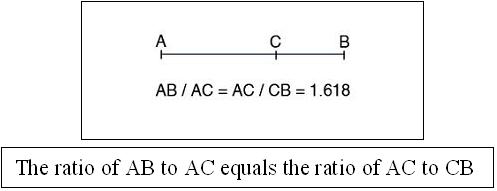
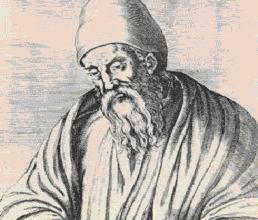
Fibonacci’s Sequence. In the 12th century, Leonardo Pisano Bigollo, known as Leonardo Fibonacci, discovered a simple numerical sequence that is the foundation for an incredible mathematical relationship behind Proportion Phi. Starting with 0 and 1, each new number in the sequence is the sum of the two numbers before it: 0, 1, 1, 2, 3, 5, 8, 13, 21, 34, 55, 89, 144… The ratio of each successive pair of numbers in the sequence approximates the Proportion Phi, as 5 divided by 3 is 1.666…, and 8 divided by 5 is 1.60. The ratios of the successive numbers in the Fibonacci sequence quickly converge on Phi. After the 40th number in the sequence, the ratio is accurate up to 15 decimal places (1.618033988749895).
Go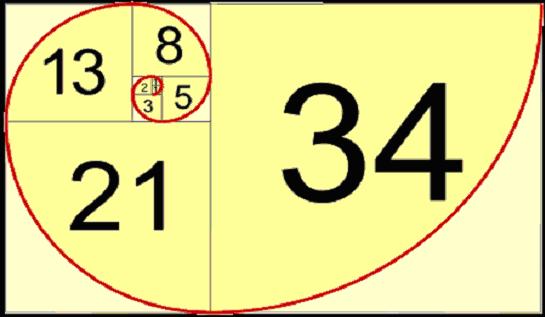 lden Rectangle. In a geometric pattern of squares, Fibonacci’s Sequence forms the Golden Rectangle. The Golden Rectangle is a sequence of squares that are added together to form proportionately increasing radius lengths. Beginning at the center, the area of one small square and another one small square are added together to equal two. The areas of one and two are added to make three. The areas of two and three are added to make five. This shape, a rectangle in which the ratio of the sides a/b is equal to the Golden Mean (Proportion Phi), can result in a nesting process that can be repeated into infinity. This takes on the form of a spiral, called the Logarithmic Spiral, and it abounds in creation.
lden Rectangle. In a geometric pattern of squares, Fibonacci’s Sequence forms the Golden Rectangle. The Golden Rectangle is a sequence of squares that are added together to form proportionately increasing radius lengths. Beginning at the center, the area of one small square and another one small square are added together to equal two. The areas of one and two are added to make three. The areas of two and three are added to make five. This shape, a rectangle in which the ratio of the sides a/b is equal to the Golden Mean (Proportion Phi), can result in a nesting process that can be repeated into infinity. This takes on the form of a spiral, called the Logarithmic Spiral, and it abounds in creation.
Pascal’s Triangle. Pascal’s Triangle was originally developed by the ancient Chinese, but it was Blaise Pascal who discovered the importance of all the patterns it contains. The Triangle is formed row by row, by each number in the row being the sum of the two directly above it.
Among those patterns found in Pascal’s Triangle are Sum of the Rows, Prime Numbers, Hockey Stick Pattern, Magic 11’s, Fibonacci’s Sequence, Triangular Numbers, Square Numbers, Polygonal Numbers, Points in a Circle, and Connection to Sierpinski’s Triangle, to name a few.

Fibonacci’s Sequence can be seen in Pascal’s Triangle when the rows of numbers are added diagonally upward from either the left or the right. Another direction the sums may be found is adding diagonally downward from either the left or the right.
Pythagoras’ Pythagorean Theorem. Pythagoras of the Island of Samos, Greece, discovered that a right triangle with sides of length a and b and a hypotenuse of length c has the following relationship: a2 + b2 = c2. A foundational quality of the Proportion Phi has a similar structure: 1 + Phi = Phi2 (1 + 1.618… = 2.618…). By taking the square root of each term in this equality, we have the dimensions of a Golden Triangle, a right triangle based on this Phi equality, where:

This triangle is illustrated following. It has an angle of 51.83º (or 51º50’), which has a cosine of 0.618 or Phi.
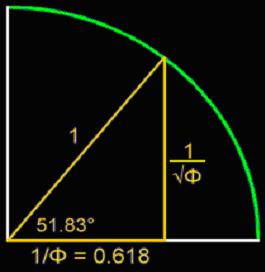
Other Golden Triangles can be created with a Phi (1.6180339…) to 1 relationship of the base and sides of the triangles. These familiar Golden Triangles are found in pentagrams and Penrose tiles.

Proportion Phi Illustrations
Proportion Phi can be found everywhere you look. Flowers, plants, stems, leaves, seeds, animals, vegetables, fruits, animals, planets, solar system, hurricanes, galaxies, geometric shapes, reproduction, human anatomy, developing fetus, DNA helix, piano keyboard, music scale, music instruments, and the universe, to name a few. Proportion Phi is our model of art and beauty. Phi has been used for centuries to form the basis of great paintings, sculptures, architectures, and buildings. The closer a human’s face and body is proportioned to Phi, the more beautiful we consider that person.
The number of petals in a flower consistently follows Fibonacci’s Sequence. Examples include the lily, which has three petals; buttercups, which have five petals; the chicory’s 21, the daisy’s 34, and so on. The distances between petal arrangements in flowers are the Proportion Phi. Petal arrangement is placed at 0.618034 per turn (out of a 360º circle) allowing the best possible exposure to sunlight and all other factors.
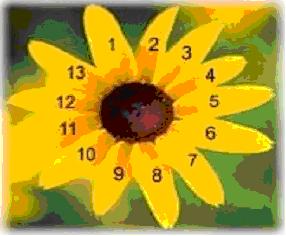
Where stems grow off a main stalk, the size of the stems, the number of stems, and the distances between leaves growing off a main stalk all also exhibit Fibonacci’s Sequence and the Proportion Phi.
The following examples show how the Logarithmic Spiral in the Golden Rectangle may be found in creation.
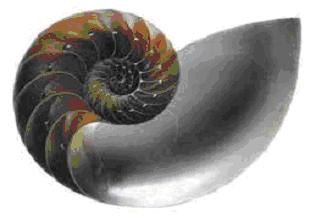
Euclid’s Geometry forms the basis of how every geometric shape known to mankind may be formed from and explained by the Proportion Phi. The following are examples of a few: (1) the pentagram whose segments are seen in the center of apples, (2) the five pointed star and all its internal segments, (3) relational sizes of planets and moons, and (4) relational sizes of planets and their characteristics.
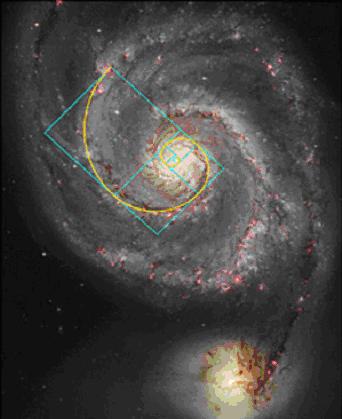
Animal bodies exhibit the Proportion Phi. Dolphins (the eye, fins, and tail all fall at Golden Sections), starfish, sand dollars, sea urchins, ants, and honey bees, to name a few, all follow Phi.
Honey bees follow Fibonacci’s Sequence in interesting ways. The most profound example is by dividing the number of females in a colony by the number of males (females always outnumber males). The answer is typically something very close to 1.618. In addition, the family tree of honey bees also follows the familiar pattern. Males have one parent (a female), whereas females have two (a female and male). Thus, when it comes to the family tree, males have 2, 3, 5, and 8 grandparents, great-grandparents, gr-gr-grandparents, and gr-gr-gr-grandparents respectively. Following the same pattern, females have 2, 3, 5, 8, 13, and so on.
Proportion Phi is found all over physical anatomy. Faces, both human and non-human, abound with examples of the Golden Ratio. The mouth and nose are each positioned at Golden Sections of the distance between the eyes and the bottom of the chin. Similar proportions can been seen from the side, and even the eye and ear itself (which follows along a spiral).
The DNA helix is another example of the Proportion Phi.
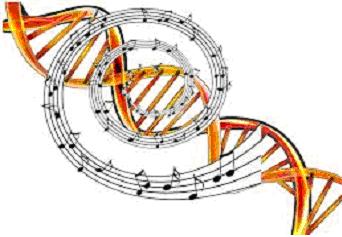
Fibonacci’s Sequence in Music. The Proportion Phi appears in the foundation of art, beauty, and all of life itself. Even music has a foundation in Fibonacci’s Sequence. Note the following description of the scale using Proportion Phi and Fibonacci’s Sequence numbers. There are 13 chromatic notes in the span of a scale through its octave. A diatonic scale is comprised of 8 notes, of which the 5th and 3rd notes create the tonal and harmonic foundation of the scale, known as a chord. The 5th note is 2 steps up from the 3rd, and the 3rd is 2 steps up from the root tone, which is the 1st note of the scale.
Also note how the piano keyboard scale of C to C above of 13 keys has 8 white keys and 5 black keys, split into groups of 3 and 2. While some might observe that there are only 12 notes in the scale, if you do not have a root and octave, a start and an end, you have no means of calculating the gradations in between. So this 13th note as the octave is essential to computing the frequencies of the other notes.
In a scale, the Dominant note is the 5th note of the major scale, which is also the 8th note of all 13 chromatic notes that comprise the octave. This provides an added instance of Fibonacci numbers in key musical relationships. Interestingly, 8/13 is .61538, which approximates Phi. What is more, the typical three chord song in the key of A is made up of A (Tonic), its Fibonacci & Phi partner E (Dominant), and D (Sub-dominant), to which A bears the same relationship as “E does to A.” This is analogous to “A is to B as B is to C” revealed by Euclid’s Geometry (Golden Section). Euclid’s Geometry, in this case stated in music notes, is “D is to A as A is to E.”
Notes in the diatonic and chromatic scales are based on natural harmonies that are created by ratios of frequencies. Ratios found in the first seven numbers of Fibonacci’s Sequence (0, 1, 1, 2, 3, 5, 8) are related to key frequencies of musical notes. The following scale examples A to A’ at Calculated Frequency, Tempered Frequency, and Natural Frequency (A = 432).
Fibonacci Ratio Calculated Frequency Tempered Frequency Note in Scale Musical Relationship When A = 432 (see following note) Octave Below Octave Above
The calculated frequency above starts with A = 440 and applies Fibonacci relationships. In practice, pianos are tuned to a tempered frequency, a man-made adaptation devised to provide improved tonality when playing in various keys. Pluck a string on a guitar, however, and search for the harmonics by lightly touching the string without making it touch the frets and you will find pure Fibonacci relationships.
Note About A432. A440 is an arbitrary standard. The American Federation of Musicians accepted the A440 as standard pitch in 1917. It was accepted by the U.S. government in 1920 and accepted internationally in 1939. Before recent times, a variety of tunings were used. James Furia and others suggested that A432 be the standard. A432 was often used by classical composers and results in a tuning of the whole number frequencies connected to numbers used in the construction of many ancient works and sacred sites, such as the Great Pyramid of Egypt. The controversy over tuning still rages, with proponents of A432 or C256 as being more natural tunings than the current A440 standard.
Many music instruments are modeled after Proportion Phi. The construction of the violin is one such example.
What’s the Point? In summary, the Proportion Phi is creative, regenerative, harmonious, and connective—from all mathematics, all sciences, all arts, to the universe, and to all of life itself.
We have only begun to realize all the ways in which the Proportion Phi is present around us. Since it appears all things are connected through the commonalty of the Proportion Phi (plants, animals, beauty, creation, music, universe, DNA, humans), why not teach everything as they are all connected? For all we know, there may be no greater model of holistic connectedness between man and everything else in the universe than the Proportion Phi. Would not it be exciting for students to discover how the Proportion Phi is exhibited in their own bodies, to how their bodies may be connected to objects in their classrooms, to how all the classroom objects are mathematically interconnected, and then beyond into the world, in an ever enlarging circumference of discoveries?
Proportion Phi may be the ultimate connection that mankind is one with music, one with creation, and one with life’s creative and procreative activities. Haïk-Vantoura rediscovered the music code written in the Hebrew (Masoretic) Bible, not just in the Psalms, but in the entire Old Testament from Moses to Malachi. She deciphered that the OT is a large continuous music composition. As she traced this form of music notation back through the Greeks, Egyptians, Hebrews, Persians, Assyrians, Babylonians, and back to the Sumerians, the earliest civilization known between the Tigress and Euphrates rivers, she concluded that music, our diatonic 7-note scale, and our chromatic 13-note scale are biologically inherent within every human being. Is not this conclusion supported by the universal commonalty of Proportion Phi? Then also, does the Proportion Phi have anything to do with mankind being created in (a complete reflection of) the Image of God (Genesis 1:27)?
References
Dvorsky, George. (n.d.). 15 uncanny examples of the golden ratio in nature. http://io9.com/5985588/15-uncanny-examples-of-the-golden-ratio-in-nature. Accessed 10/23/2013, 3:49 PM EST.
Haïk-Vantoura, S. (1991). The music of the Bible revealed: The deciphering of a millenary notation. Berkeley, CA: BIBAL Press. ISBN 0-941037-10-X.
Hemenway, P. (2005). Divine proportion: Φ (Phi) in art, nature, and science. New York: Sterling Publishing Co., Inc.
Livio, M. (2002). The golden ratio: The story of Phi, the world’s most astonishing number. New York: Broadway Books.
Meisner, Gary. (2012, May 13). Phi and Fibonacci in golden traingles: Or Pythagoras meets Fibonacci. http://www.goldennumber.net/triangles/. Accessed 10/23/2013, 3:00 PM EST.
Meisner, Gary. (2012, May 15). Pascal’s triangle. http:// www.goldennumber.net/pascals-triangle/. Accessed 10/23/2013, 3:16 PM EST.
Meisner, Gary. (2012, May 15). What is Fibonacci? Or, more appropriately, who was Fibonacci and what is the Fibonacci sequence? http://www.goldennumber.net/fibonacci-series/. Accessed 10/23/2013, 3:42 PM EST.
Meisner, Gary. (2012, May 4). Music and the Fibonacci series and phi. http://www.goldennumber.net/music/. Accessed 10/23-2013, 3:37 PM EST.
Meisner, Gary. (2013, August 5). Phi and the golden section in architecture. http://www.goldennumber.net/architecture/. Accessed 10/23/2013, 2:54 PM EST.
Pascal’s triangle: And its patterns. (n.d.). http://ptri1.tripod.com/. Accessed 10/23/2013, 3:28 PM EST.
Dr. Knauss mentors student teachers and regular teachers into teaching excellence. He taught for 3 decades in inner-city public schools, winning over street kids into being like family, became one of the principle curriculum writers for an award-winning, internationally-recognized music department. He retired from public schools, completed a Ph.D. in Music Education, and presently is an adjunct music education professor at Baptist Bible College.
Ph.D. in Music Education
Doc. Humane Letters, Honouris Causa
Proportion Phi. At first glance the Proportion Phi looks like an academic, lifeless math formula, but a deeper look reveals it is 100% aesthetics and forms the basis of all life and design. In short, it is the grand design of everything seen around you.
It is more holistically-connected than can possibly be imagined. It is named the Golden Ratio, also known as the Golden Mean, Divine Proportion, Golden Number, Golden Section, and the Golden Rectangle. Mathematicians call it the Proportion Phi (fee), which is held by many as the world’s most astonishing number. Proportion Phi is named after Phidias, (circa 480—430 BC), a Greek sculptor, painter and architect, the son of Charmides of Athens.
Proportion Phi is found in an infinite number of instances throughout all of creation from one side of the universe to the other. The Proportion Phi is found in Euclid’s Euclidean Geometry, Fibonacci’s Sequence, Pascal’s Triangle (originally developed by the ancient Chinese), and Pythagoras’ Pythagorean Theorem, to name a few.
Proportion Phi is a number of infinite decimal integers like Pi (3.14159…), known as irrational—that is neither a whole number (1,2,3) nor a ratio of whole numbers (1/2,2/3,3/4). The Proportion Phi is a never ending, never-repeating decimal number = 1.618033988749895… An irrational number of infinite decimal integers is suggestive of both infinity and eternity.
Euclidean Geometry (Golden Section). Euclid may have been the first to define the Proportion Phi geometrically. He defined it as: “A straight line is said to have been cut in extreme and mean ratio when, as the whole line is to the greater segment, so is the greater segment to the lesser one.”
Fibonacci’s Sequence. In the 12th century, Leonardo Pisano Bigollo, known as Leonardo Fibonacci, discovered a simple numerical sequence that is the foundation for an incredible mathematical relationship behind Proportion Phi. Starting with 0 and 1, each new number in the sequence is the sum of the two numbers before it: 0, 1, 1, 2, 3, 5, 8, 13, 21, 34, 55, 89, 144… The ratio of each successive pair of numbers in the sequence approximates the Proportion Phi, as 5 divided by 3 is 1.666…, and 8 divided by 5 is 1.60. The ratios of the successive numbers in the Fibonacci sequence quickly converge on Phi. After the 40th number in the sequence, the ratio is accurate up to 15 decimal places (1.618033988749895).
Go
Pascal’s Triangle. Pascal’s Triangle was originally developed by the ancient Chinese, but it was Blaise Pascal who discovered the importance of all the patterns it contains. The Triangle is formed row by row, by each number in the row being the sum of the two directly above it.
Among those patterns found in Pascal’s Triangle are Sum of the Rows, Prime Numbers, Hockey Stick Pattern, Magic 11’s, Fibonacci’s Sequence, Triangular Numbers, Square Numbers, Polygonal Numbers, Points in a Circle, and Connection to Sierpinski’s Triangle, to name a few.
Fibonacci’s Sequence can be seen in Pascal’s Triangle when the rows of numbers are added diagonally upward from either the left or the right. Another direction the sums may be found is adding diagonally downward from either the left or the right.
Pythagoras’ Pythagorean Theorem. Pythagoras of the Island of Samos, Greece, discovered that a right triangle with sides of length a and b and a hypotenuse of length c has the following relationship: a2 + b2 = c2. A foundational quality of the Proportion Phi has a similar structure: 1 + Phi = Phi2 (1 + 1.618… = 2.618…). By taking the square root of each term in this equality, we have the dimensions of a Golden Triangle, a right triangle based on this Phi equality, where:
This triangle is illustrated following. It has an angle of 51.83º (or 51º50’), which has a cosine of 0.618 or Phi.
Other Golden Triangles can be created with a Phi (1.6180339…) to 1 relationship of the base and sides of the triangles. These familiar Golden Triangles are found in pentagrams and Penrose tiles.
Proportion Phi Illustrations
Proportion Phi can be found everywhere you look. Flowers, plants, stems, leaves, seeds, animals, vegetables, fruits, animals, planets, solar system, hurricanes, galaxies, geometric shapes, reproduction, human anatomy, developing fetus, DNA helix, piano keyboard, music scale, music instruments, and the universe, to name a few. Proportion Phi is our model of art and beauty. Phi has been used for centuries to form the basis of great paintings, sculptures, architectures, and buildings. The closer a human’s face and body is proportioned to Phi, the more beautiful we consider that person.
The number of petals in a flower consistently follows Fibonacci’s Sequence. Examples include the lily, which has three petals; buttercups, which have five petals; the chicory’s 21, the daisy’s 34, and so on. The distances between petal arrangements in flowers are the Proportion Phi. Petal arrangement is placed at 0.618034 per turn (out of a 360º circle) allowing the best possible exposure to sunlight and all other factors.
Where stems grow off a main stalk, the size of the stems, the number of stems, and the distances between leaves growing off a main stalk all also exhibit Fibonacci’s Sequence and the Proportion Phi.
The following examples show how the Logarithmic Spiral in the Golden Rectangle may be found in creation.
Euclid’s Geometry forms the basis of how every geometric shape known to mankind may be formed from and explained by the Proportion Phi. The following are examples of a few: (1) the pentagram whose segments are seen in the center of apples, (2) the five pointed star and all its internal segments, (3) relational sizes of planets and moons, and (4) relational sizes of planets and their characteristics.
Animal bodies exhibit the Proportion Phi. Dolphins (the eye, fins, and tail all fall at Golden Sections), starfish, sand dollars, sea urchins, ants, and honey bees, to name a few, all follow Phi.
Honey bees follow Fibonacci’s Sequence in interesting ways. The most profound example is by dividing the number of females in a colony by the number of males (females always outnumber males). The answer is typically something very close to 1.618. In addition, the family tree of honey bees also follows the familiar pattern. Males have one parent (a female), whereas females have two (a female and male). Thus, when it comes to the family tree, males have 2, 3, 5, and 8 grandparents, great-grandparents, gr-gr-grandparents, and gr-gr-gr-grandparents respectively. Following the same pattern, females have 2, 3, 5, 8, 13, and so on.
Proportion Phi is found all over physical anatomy. Faces, both human and non-human, abound with examples of the Golden Ratio. The mouth and nose are each positioned at Golden Sections of the distance between the eyes and the bottom of the chin. Similar proportions can been seen from the side, and even the eye and ear itself (which follows along a spiral).
The DNA helix is another example of the Proportion Phi.
Fibonacci’s Sequence in Music. The Proportion Phi appears in the foundation of art, beauty, and all of life itself. Even music has a foundation in Fibonacci’s Sequence. Note the following description of the scale using Proportion Phi and Fibonacci’s Sequence numbers. There are 13 chromatic notes in the span of a scale through its octave. A diatonic scale is comprised of 8 notes, of which the 5th and 3rd notes create the tonal and harmonic foundation of the scale, known as a chord. The 5th note is 2 steps up from the 3rd, and the 3rd is 2 steps up from the root tone, which is the 1st note of the scale.
Also note how the piano keyboard scale of C to C above of 13 keys has 8 white keys and 5 black keys, split into groups of 3 and 2. While some might observe that there are only 12 notes in the scale, if you do not have a root and octave, a start and an end, you have no means of calculating the gradations in between. So this 13th note as the octave is essential to computing the frequencies of the other notes.
In a scale, the Dominant note is the 5th note of the major scale, which is also the 8th note of all 13 chromatic notes that comprise the octave. This provides an added instance of Fibonacci numbers in key musical relationships. Interestingly, 8/13 is .61538, which approximates Phi. What is more, the typical three chord song in the key of A is made up of A (Tonic), its Fibonacci & Phi partner E (Dominant), and D (Sub-dominant), to which A bears the same relationship as “E does to A.” This is analogous to “A is to B as B is to C” revealed by Euclid’s Geometry (Golden Section). Euclid’s Geometry, in this case stated in music notes, is “D is to A as A is to E.”
Notes in the diatonic and chromatic scales are based on natural harmonies that are created by ratios of frequencies. Ratios found in the first seven numbers of Fibonacci’s Sequence (0, 1, 1, 2, 3, 5, 8) are related to key frequencies of musical notes. The following scale examples A to A’ at Calculated Frequency, Tempered Frequency, and Natural Frequency (A = 432).
Fibonacci Ratio Calculated Frequency Tempered Frequency Note in Scale Musical Relationship When A = 432 (see following note) Octave Below Octave Above
The calculated frequency above starts with A = 440 and applies Fibonacci relationships. In practice, pianos are tuned to a tempered frequency, a man-made adaptation devised to provide improved tonality when playing in various keys. Pluck a string on a guitar, however, and search for the harmonics by lightly touching the string without making it touch the frets and you will find pure Fibonacci relationships.
Note About A432. A440 is an arbitrary standard. The American Federation of Musicians accepted the A440 as standard pitch in 1917. It was accepted by the U.S. government in 1920 and accepted internationally in 1939. Before recent times, a variety of tunings were used. James Furia and others suggested that A432 be the standard. A432 was often used by classical composers and results in a tuning of the whole number frequencies connected to numbers used in the construction of many ancient works and sacred sites, such as the Great Pyramid of Egypt. The controversy over tuning still rages, with proponents of A432 or C256 as being more natural tunings than the current A440 standard.
Many music instruments are modeled after Proportion Phi. The construction of the violin is one such example.
What’s the Point? In summary, the Proportion Phi is creative, regenerative, harmonious, and connective—from all mathematics, all sciences, all arts, to the universe, and to all of life itself.
We have only begun to realize all the ways in which the Proportion Phi is present around us. Since it appears all things are connected through the commonalty of the Proportion Phi (plants, animals, beauty, creation, music, universe, DNA, humans), why not teach everything as they are all connected? For all we know, there may be no greater model of holistic connectedness between man and everything else in the universe than the Proportion Phi. Would not it be exciting for students to discover how the Proportion Phi is exhibited in their own bodies, to how their bodies may be connected to objects in their classrooms, to how all the classroom objects are mathematically interconnected, and then beyond into the world, in an ever enlarging circumference of discoveries?
Proportion Phi may be the ultimate connection that mankind is one with music, one with creation, and one with life’s creative and procreative activities. Haïk-Vantoura rediscovered the music code written in the Hebrew (Masoretic) Bible, not just in the Psalms, but in the entire Old Testament from Moses to Malachi. She deciphered that the OT is a large continuous music composition. As she traced this form of music notation back through the Greeks, Egyptians, Hebrews, Persians, Assyrians, Babylonians, and back to the Sumerians, the earliest civilization known between the Tigress and Euphrates rivers, she concluded that music, our diatonic 7-note scale, and our chromatic 13-note scale are biologically inherent within every human being. Is not this conclusion supported by the universal commonalty of Proportion Phi? Then also, does the Proportion Phi have anything to do with mankind being created in (a complete reflection of) the Image of God (Genesis 1:27)?
References
Dvorsky, George. (n.d.). 15 uncanny examples of the golden ratio in nature. http://io9.com/5985588/15-uncanny-examples-of-the-golden-ratio-in-nature. Accessed 10/23/2013, 3:49 PM EST.
Haïk-Vantoura, S. (1991). The music of the Bible revealed: The deciphering of a millenary notation. Berkeley, CA: BIBAL Press. ISBN 0-941037-10-X.
Hemenway, P. (2005). Divine proportion: Φ (Phi) in art, nature, and science. New York: Sterling Publishing Co., Inc.
Livio, M. (2002). The golden ratio: The story of Phi, the world’s most astonishing number. New York: Broadway Books.
Meisner, Gary. (2012, May 13). Phi and Fibonacci in golden traingles: Or Pythagoras meets Fibonacci. http://www.goldennumber.net/triangles/. Accessed 10/23/2013, 3:00 PM EST.
Meisner, Gary. (2012, May 15). Pascal’s triangle. http:// www.goldennumber.net/pascals-triangle/. Accessed 10/23/2013, 3:16 PM EST.
Meisner, Gary. (2012, May 15). What is Fibonacci? Or, more appropriately, who was Fibonacci and what is the Fibonacci sequence? http://www.goldennumber.net/fibonacci-series/. Accessed 10/23/2013, 3:42 PM EST.
Meisner, Gary. (2012, May 4). Music and the Fibonacci series and phi. http://www.goldennumber.net/music/. Accessed 10/23-2013, 3:37 PM EST.
Meisner, Gary. (2013, August 5). Phi and the golden section in architecture. http://www.goldennumber.net/architecture/. Accessed 10/23/2013, 2:54 PM EST.
Pascal’s triangle: And its patterns. (n.d.). http://ptri1.tripod.com/. Accessed 10/23/2013, 3:28 PM EST.
Dr. Knauss mentors student teachers and regular teachers into teaching excellence. He taught for 3 decades in inner-city public schools, winning over street kids into being like family, became one of the principle curriculum writers for an award-winning, internationally-recognized music department. He retired from public schools, completed a Ph.D. in Music Education, and presently is an adjunct music education professor at Baptist Bible College.





